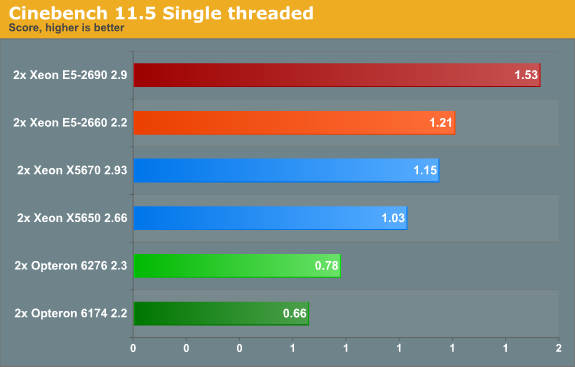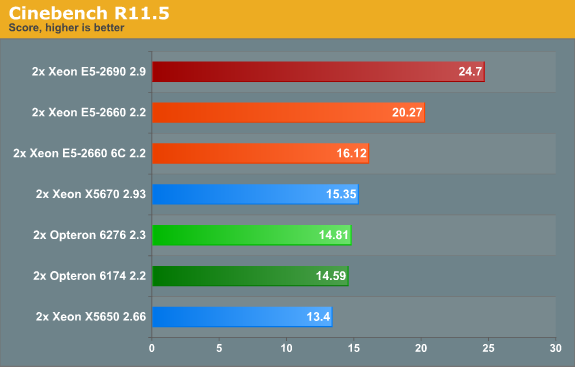The Xeon E5-2600: Dual Sandy Bridge for Servers
by Johan De Gelas on March 6, 2012 9:27 AM EST- Posted in
- IT Computing
- Virtualization
- Xeon
- Opteron
- Cloud Computing
Rendering Performance: Cinebench
Cinebench, based on MAXON's CINEMA 4D software, is probably one of the most popular benchmarks around as it is pretty easy to perform this benchmark on your own home machine. The benchmark supports 64 threads, more than enough for our 24- and 32-thread test servers. First we tested single-threaded performance, to evaluate the performance of each core.

Cinebench achieves an IPC between 1.4 and 1.8 and is mostly dominated by SSE2 code. The Sandy Bridge core offers about 33% better single-threaded SSE performance. We checked: the 33% can be split up into 21% gains from architectural improvements and 12% from the improved Turbo capabilities.
Let's check out the multi-threaded score.

Prior to the launch of the Xeon E5 series, the Opteron 6276 offered a better performance per dollar ratio than comparable Xeon 5600s due to their similar performance at a much lower pricepoint. Now that the Xeon E5 has arrived, the tables have turned. If Xeon E5 servers are in the same price range as Xeon 5600 servers, the Xeon E5-2630 will offer the best performance/price ratio.
And if you want top performance, Intel is the only option. Case in point: a dual Xeon E5-2690 comes close to what a Quad Opteron 6276 can deliver, with the dual Xeon scoring 24.7 while the quad Opteron scores 26.4.










81 Comments
View All Comments
MrSpadge - Tuesday, March 6, 2012 - link
Put some sarcasm tags in there to save some people from getting confused...cynic783 - Tuesday, March 6, 2012 - link
definitely sarcastic. i was actually surprised not to see any fanbois so I thought I'd pretendbadjohny - Tuesday, March 6, 2012 - link
I have no doubt these chips or something similar will end up in the new mac pros. Who are in a very bad need of a refresh.Shuxclams - Tuesday, March 6, 2012 - link
Looking at a complete visualization transformation in our server room, looks like the decision was made for us as far as architecture. Wow....TeXWiller - Tuesday, March 6, 2012 - link
<quote>The new Xeon also supports faster DDR-3 1600. Contrary to the Interlagos Opteron which can only support this memory speed with one DIMM per channel</quote>Interlagos supports memory up to DDR3-1600 using two single rank memory modules, or one single rank and one double rank module if using registered memory, and two single rank modules if using unbuffered memory. DDR3-1866 is supported on a single load-reduced registered, or on a single unbuffered module per channel. It depends on the board manufacturer and more importantly, it can be all read on the manual, so to speak.davegraham - Tuesday, March 6, 2012 - link
AMD Interlagos can support more than 1 DDR3-1600 ECC/REG dimm per channel. I run 8 on a single socket 6276 and it works at the rated speed.TeXWiller - Wednesday, March 7, 2012 - link
Too bad these kinds of errors in the articles are not usually fixed.JohanAnandtech - Wednesday, March 7, 2012 - link
I will double check .meloz - Tuesday, March 6, 2012 - link
Just wanted to congratulate Johan on a job well done. Very thorough analysis, Intel have achieved a very dominant position with this new platform and this is reflected in pricing of their processors as well!AMD was already a sub 10% niche (with a market share to mirror) in the data center, now even that niche has evaporated.
New Opterons (based on Piledriver) might decrease the performance gap to Intel under certain benchmarks, but I doubt they will beat Intel. Intel has plenty of SKUs above the quickest AMD Opterons to adjust prices and kill any new challenge from AMD, instantly.
JohanAnandtech - Wednesday, March 7, 2012 - link
Thanks! Although I hope Intel gets a bit more competition though.